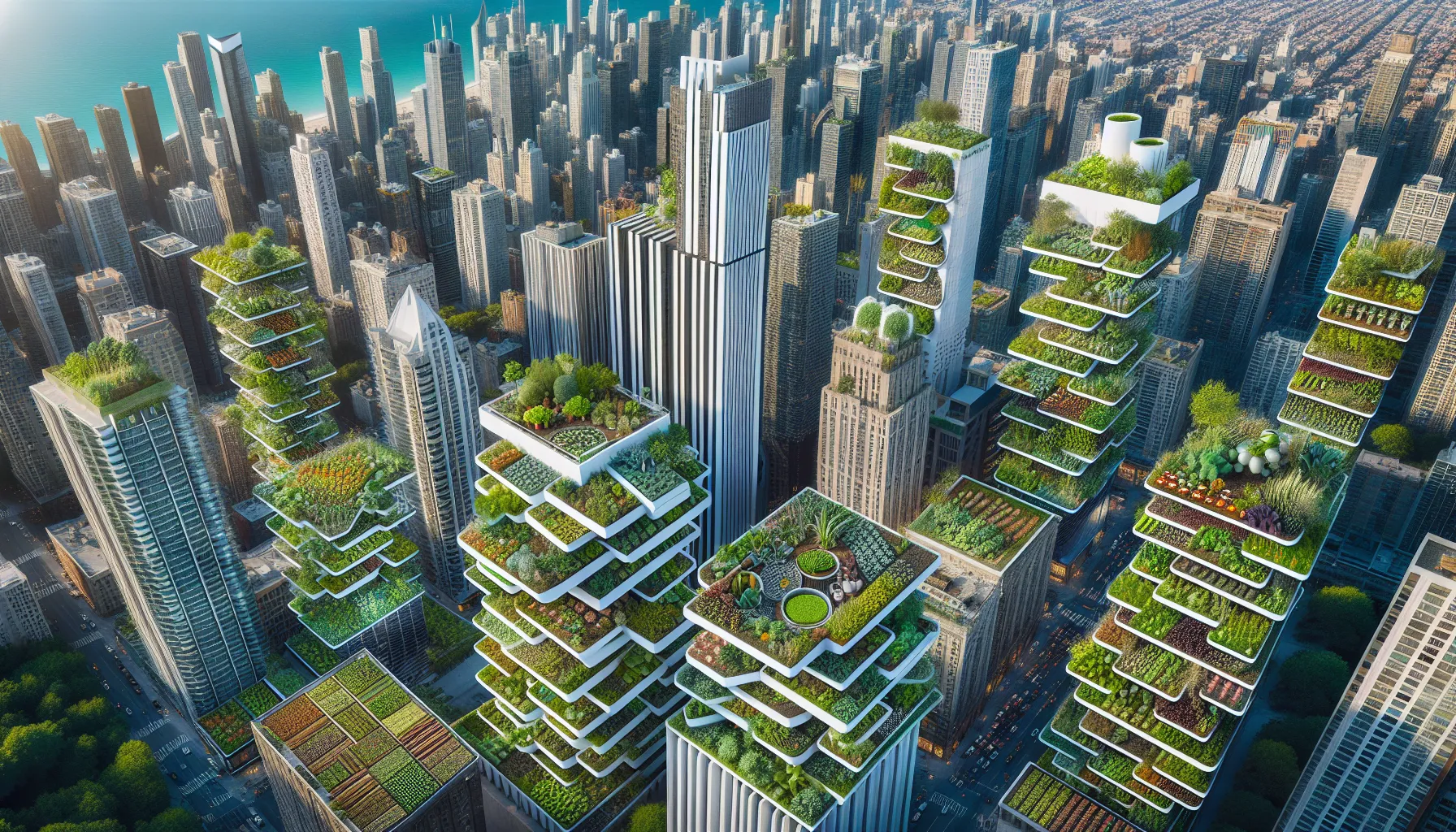Urban farming has emerged as a powerful solution to address food sustainability challenges in cities worldwide. This IELTS Reading practice test explores the impact of urban agriculture on food security, environmental sustainability, and community well-being. As you prepare for your IELTS exam, this comprehensive practice will help you improve your reading skills while learning about an important global trend.
Table Of Contents
 Urban farming in modern cityscape
Urban farming in modern cityscape
IELTS Reading Practice Test
Passage 1 (Easy Text)
Urban Farming: A Growing Trend
Urban farming, also known as urban agriculture, is the practice of cultivating, processing, and distributing food in or around urban areas. This concept has gained significant traction in recent years as cities worldwide grapple with food security issues and seek sustainable solutions. Urban farming takes many forms, from rooftop gardens and vertical farms to community allotments and indoor hydroponic systems.
One of the primary benefits of urban farming is its potential to increase food security in cities. By producing food locally, urban areas can reduce their dependence on long-distance food transportation, which is often costly and carbon-intensive. This localized production also ensures fresher produce for urban consumers, as fruits and vegetables can be harvested and consumed within a matter of hours or days.
Moreover, urban farming contributes to environmental sustainability. Green spaces in cities, including urban farms, help to mitigate the urban heat island effect, improve air quality, and increase biodiversity. Rooftop gardens and vertical farms can also help to insulate buildings, reducing energy consumption for heating and cooling.
The social benefits of urban farming are equally significant. Community gardens foster social connections among neighbors, provide educational opportunities for children and adults alike, and promote a sense of ownership and pride in local food production. In some cities, urban farming initiatives have been used as a tool for urban regeneration, transforming vacant lots into productive green spaces.
However, urban farming is not without its challenges. Limited space, soil contamination, and restrictive zoning laws can pose obstacles to urban farmers. Additionally, the economic viability of urban farming projects often depends on careful planning and management.
Despite these challenges, the future of urban farming looks promising. Innovations in technology, such as vertical farming and hydroponics, are making it possible to produce more food in smaller spaces. As cities continue to grow and climate change threatens traditional agricultural systems, urban farming is likely to play an increasingly important role in promoting food sustainability.
Questions 1-7
Do the following statements agree with the information given in the reading passage?
Write:
TRUE if the statement agrees with the information
FALSE if the statement contradicts the information
NOT GIVEN if there is no information on this
- Urban farming only takes place on rooftops and in community gardens.
- Local food production through urban farming can reduce the need for long-distance food transportation.
- Urban farms can help reduce the urban heat island effect.
- All urban farming projects are economically viable.
- Community gardens can help build social connections among neighbors.
- Urban farming always requires large amounts of space.
- Vertical farming and hydroponics are making urban farming more efficient.
Questions 8-13
Complete the sentences below.
Choose NO MORE THAN TWO WORDS from the passage for each answer.
- Urban farming ensures that produce is ___ for city consumers.
- Green spaces in cities, including urban farms, can improve ___ and increase biodiversity.
- Some cities have used urban farming as a tool for ___.
- ___ can be a challenge for urban farming in some areas.
- The economic success of urban farming projects often depends on careful ___ and management.
- As cities grow and ___ threatens traditional agriculture, urban farming may become more important.
Passage 2 (Medium Text)
Innovations in Urban Farming Technologies
The rapid growth of urban populations worldwide has intensified the need for sustainable food production systems within cities. This demand has sparked a wave of innovations in urban farming technologies, revolutionizing the way we think about agriculture in urban environments. These advancements are not only addressing food security concerns but are also contributing to the creation of more resilient and sustainable urban ecosystems.
One of the most promising developments in urban farming is vertical farming. This technique involves growing crops in vertically stacked layers, often incorporating controlled-environment agriculture (CEA) technology. Vertical farms can be established in a variety of urban structures, from purpose-built skyscrapers to retrofitted warehouses. By utilizing artificial lighting, hydroponic or aeroponic growing systems, and precise climate control, vertical farms can produce crops year-round, regardless of external weather conditions. This approach significantly increases yield per square foot compared to traditional farming methods, making it particularly suitable for dense urban areas where space is at a premium.
Another innovative approach gaining traction is aquaponics, a system that combines conventional aquaculture (raising aquatic animals such as fish or prawns in tanks) with hydroponics (cultivating plants in water) in a symbiotic environment. In aquaponic systems, the waste produced by farmed fish or other aquatic creatures supplies nutrients for the plants, which in turn purify the water for the aquatic animals. This closed-loop system is highly efficient in terms of water usage and can produce both plant and protein sources in a compact urban setting.
Rooftop farming has also seen significant advancements. Modern rooftop farms go beyond simple container gardening, often incorporating sophisticated irrigation systems, lightweight growing media, and even automated harvesting technologies. Some rooftop farms are now being integrated into building designs from the outset, with architects and engineers considering factors such as weight distribution, water management, and energy efficiency. These green roofs not only produce food but also provide insulation, reduce stormwater runoff, and help mitigate the urban heat island effect.
The rise of smart farming technologies is further enhancing the efficiency and productivity of urban agriculture. Internet of Things (IoT) devices, sensors, and AI-powered systems are being employed to monitor and optimize growing conditions. These technologies can control factors such as lighting, temperature, humidity, and nutrient delivery with precision, often remotely via smartphone apps. This level of control allows for the fine-tuning of growing conditions for specific crops, potentially increasing yields and reducing resource consumption.
Urban farming is also benefiting from advancements in renewable energy technologies. Solar panels are increasingly being integrated into urban farm designs, providing clean energy for lighting, climate control, and other operational needs. Some innovative projects are even exploring the potential of translucent solar panels that can be used in greenhouses, generating electricity while allowing sunlight to reach the plants below.
While these technological innovations offer exciting possibilities for urban food production, they also present challenges. The initial investment required for high-tech urban farming systems can be substantial, potentially limiting their adoption. Additionally, the energy requirements for some of these systems, particularly in vertical farming, can be significant if not carefully managed. There are also ongoing debates about the nutritional quality of produce grown in fully artificial environments compared to traditional soil-based agriculture.
Despite these challenges, the continued development and refinement of urban farming technologies are crucial for addressing the food sustainability needs of growing urban populations. As these innovations evolve and become more accessible, they have the potential to transform cities into productive agricultural landscapes, enhancing food security, environmental sustainability, and urban resilience in the face of climate change and other global challenges.
Questions 14-19
Choose the correct letter, A, B, C, or D.
-
According to the passage, vertical farming:
A) Can only be done in purpose-built skyscrapers
B) Uses less space than traditional farming methods
C) Is less efficient than conventional agriculture
D) Requires natural sunlight to be effective -
Aquaponics systems are described as:
A) Inefficient in terms of water usage
B) Only suitable for fish farming
C) A closed-loop system combining aquaculture and hydroponics
D) Less productive than traditional farming methods -
Modern rooftop farms:
A) Are limited to simple container gardening
B) Always require structural modifications to existing buildings
C) Can help reduce the urban heat island effect
D) Are not suitable for food production -
Smart farming technologies in urban agriculture:
A) Are mainly used for entertainment purposes
B) Can only be controlled on-site
C) Decrease crop yields
D) Allow for precise control of growing conditions -
The integration of renewable energy in urban farming:
A) Is not feasible due to space constraints
B) Includes exploring the use of translucent solar panels in greenhouses
C) Has been proven to be ineffective
D) Is only possible on ground-level farms -
One of the challenges of high-tech urban farming systems mentioned in the passage is:
A) The lack of available technologies
B) The high initial investment required
C) The inability to grow a variety of crops
D) The excessive yields produced
Questions 20-26
Complete the summary below.
Choose NO MORE THAN TWO WORDS from the passage for each answer.
Urban farming technologies are evolving to meet the challenges of food production in cities. Vertical farming utilizes (20) growing systems and precise climate control to produce crops year-round. Aquaponics combines raising aquatic animals with (21) in a symbiotic system. Advanced rooftop farms often incorporate sophisticated (22) systems and lightweight growing media. (23) technologies, including IoT devices and AI-powered systems, are being used to optimize growing conditions. The integration of (24) is making urban farms more sustainable, with some projects exploring translucent solar panels for greenhouses. Despite the potential benefits, challenges include high (25) costs and debates about the (26) ___ of produce grown in artificial environments.
Passage 3 (Hard Text)
The Socioeconomic Implications of Urban Agriculture
The proliferation of urban agriculture in recent years has not only transformed the physical landscapes of cities but has also engendered significant socioeconomic changes. This multifaceted phenomenon extends far beyond mere food production, interweaving complex threads of social equity, economic opportunity, and community resilience. As urban farming initiatives burgeon worldwide, they are increasingly being recognized as powerful catalysts for sustainable urban development, capable of addressing a spectrum of challenges faced by modern cities.
One of the most salient socioeconomic impacts of urban agriculture is its potential to ameliorate food insecurity in urban areas. In many cities, particularly in developing countries, access to fresh, nutritious food is often limited in low-income neighborhoods, creating what are colloquially termed “food deserts.” Urban farming projects, especially community gardens and small-scale local farms, can significantly improve food access in these areas. By providing locally grown produce at affordable prices, these initiatives not only enhance the nutritional status of community members but also foster a sense of food sovereignty. This localized approach to food production can help insulate communities from the vagaries of global food markets and supply chain disruptions, thereby enhancing urban food system resilience.
Moreover, urban agriculture has emerged as a promising vector for economic development and job creation. The urban farming sector encompasses a wide range of employment opportunities, from manual labor in gardens and farms to high-skilled positions in areas such as hydroponics, vertical farming technologies, and agricultural biotechnology. In some cities, urban agriculture has spawned new micro-enterprises and cooperatives, providing income-generating opportunities for marginalized groups, including unemployed youth, refugees, and individuals with limited formal education. The economic multiplier effect of these initiatives can be substantial, as they often stimulate the growth of ancillary businesses such as local food processing, packaging, and distribution services.
The social capital generated by urban farming projects is another critical, albeit less tangible, benefit. Community gardens and shared farming spaces serve as nodes of social interaction, fostering connections across diverse demographic groups and strengthening community cohesion. These spaces often become hubs for knowledge exchange, intergenerational learning, and the preservation of cultural food traditions. In many instances, urban farming initiatives have been observed to contribute to crime reduction and neighborhood revitalization by activating previously neglected spaces and increasing community engagement.
Urban agriculture also intersects with education and skills development in meaningful ways. Many urban farming projects incorporate educational programs, offering workshops on topics ranging from sustainable gardening practices to nutrition and cooking skills. These programs not only enhance food literacy but also provide valuable vocational training, particularly for youth. In some cities, urban farms have formed partnerships with schools and universities, integrating hands-on agricultural experiences into formal curricula and research programs.
The environmental benefits of urban agriculture, while primarily ecological, have significant socioeconomic ramifications. Green spaces created by urban farms help mitigate the urban heat island effect, potentially reducing energy costs for cooling in surrounding buildings. Additionally, by shortening food supply chains, urban agriculture can contribute to reducing the carbon footprint associated with food transportation, aligning with cities’ climate action goals and potentially yielding economic benefits through carbon offset mechanisms.
However, the socioeconomic impacts of urban agriculture are not uniformly positive and can sometimes exacerbate existing inequalities if not carefully managed. In some instances, urban farming initiatives, particularly those that are high-tech or commercial in nature, can contribute to gentrification processes, potentially displacing long-term residents as property values increase. There are also concerns about soil contamination in urban areas, which can pose health risks if not properly addressed, potentially creating new public health challenges.
The governance and policy frameworks surrounding urban agriculture are critical in shaping its socioeconomic outcomes. Progressive urban planning policies that integrate agriculture into city development plans can maximize the benefits of urban farming while mitigating potential negative impacts. Some cities have implemented zoning changes to facilitate urban agriculture, while others have created incentive programs to encourage the conversion of vacant lots into productive green spaces. The success of these policy interventions often depends on their ability to balance various stakeholder interests and to address complex issues such as land tenure, water rights, and food safety regulations in urban contexts.
As urban agriculture continues to evolve, its socioeconomic implications are likely to become increasingly pronounced and nuanced. The integration of new technologies, such as AI-driven farming systems and blockchain for supply chain management, may further transform the urban farming landscape, creating new economic opportunities and challenges. Concurrently, the growing recognition of urban agriculture’s role in building resilient food systems may lead to its greater integration into urban climate adaptation and disaster preparedness strategies.
In conclusion, the socioeconomic dimensions of urban agriculture are multifaceted and context-dependent. While it offers significant potential for enhancing food security, creating economic opportunities, and strengthening community bonds, realizing these benefits requires careful planning, inclusive policies, and ongoing community engagement. As cities continue to grapple with challenges of sustainability and equity, urban agriculture stands as a promising, albeit complex, tool in the urban development toolkit, capable of contributing to more resilient, equitable, and vibrant urban futures.
Questions 27-32
Choose the correct letter, A, B, C, or D.
-
According to the passage, urban agriculture primarily addresses:
A) Only food production issues in cities
B) A range of urban challenges including social and economic issues
C) Environmental problems exclusively
D) The needs of commercial farmers -
The term “food deserts” in the passage refers to:
A) Areas where no food can be grown
B) Regions with extreme drought conditions
C) Urban areas with limited access to fresh, nutritious food
D) Places where only processed foods are available -
Urban agriculture’s contribution to economic development includes:
A) Only creating low-skilled jobs
B) Providing a range of employment opportunities across skill levels
C) Replacing traditional agricultural jobs
D) Focusing solely on high-tech farming positions -
The social capital generated by urban farming projects is described as:
A) Tangible and easily measurable
B) Irrelevant to community development
C) Limited to economic benefits
D) Important for community cohesion and knowledge exchange -
The passage suggests that the environmental benefits of urban agriculture:
A) Have no economic implications
B) Are limited to aesthetic improvements
C) Can lead to economic benefits such as reduced energy costs
D) Are detrimental to urban development -
The governance and policy frameworks for urban agriculture are described as:
A) Unnecessary for its development
B) Critical in shaping its socioeconomic outcomes
C) Only relevant in developing countries
D) Focused solely on commercial farming
Questions 33-40
Complete the summary below.
Choose NO MORE THAN THREE WORDS from the passage for each answer.
Urban agriculture has significant socioeconomic implications for cities. It can help address (33) in low-income areas by providing locally grown produce. The sector offers various (34) , ranging from manual labor to high-skilled positions in advanced farming technologies. Community gardens often serve as spaces for (35) and can contribute to neighborhood revitalization. Many urban farming projects include (36) , which enhance food literacy and provide vocational training. The environmental benefits of urban agriculture, such as mitigating the (37) , can also have economic advantages. However, urban farming can sometimes contribute to (38) if not properly managed. The success of urban agriculture often depends on (39) that integrate it into city development plans. As the field evolves, new technologies may create additional (40) and challenges in the urban farming landscape.
Answer Key
Passage 1 (Easy Text)
- FALSE
- TRUE
- TRUE
- FALSE
- TRUE
- FALSE
- TRUE
- fresher
- air quality
- urban regeneration
- Soil contamination
- planning
- climate change
Passage 2 (Medium Text)
-
B
-
C
-
C
-
D
-
B
-
B
-
hydroponic OR aeroponic
-
hydroponics
-
irrigation
-
Smart farming
-
renewable energy


